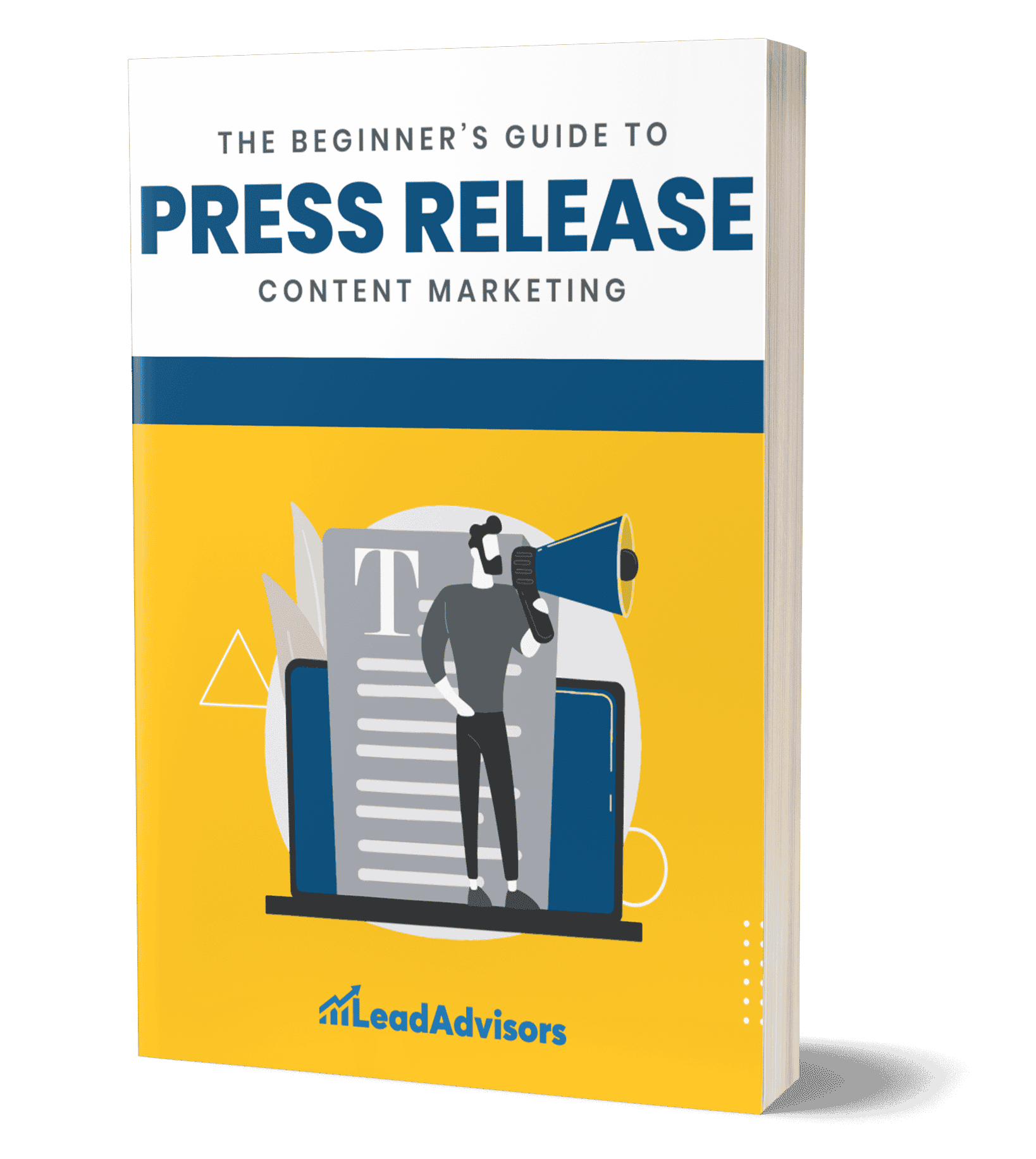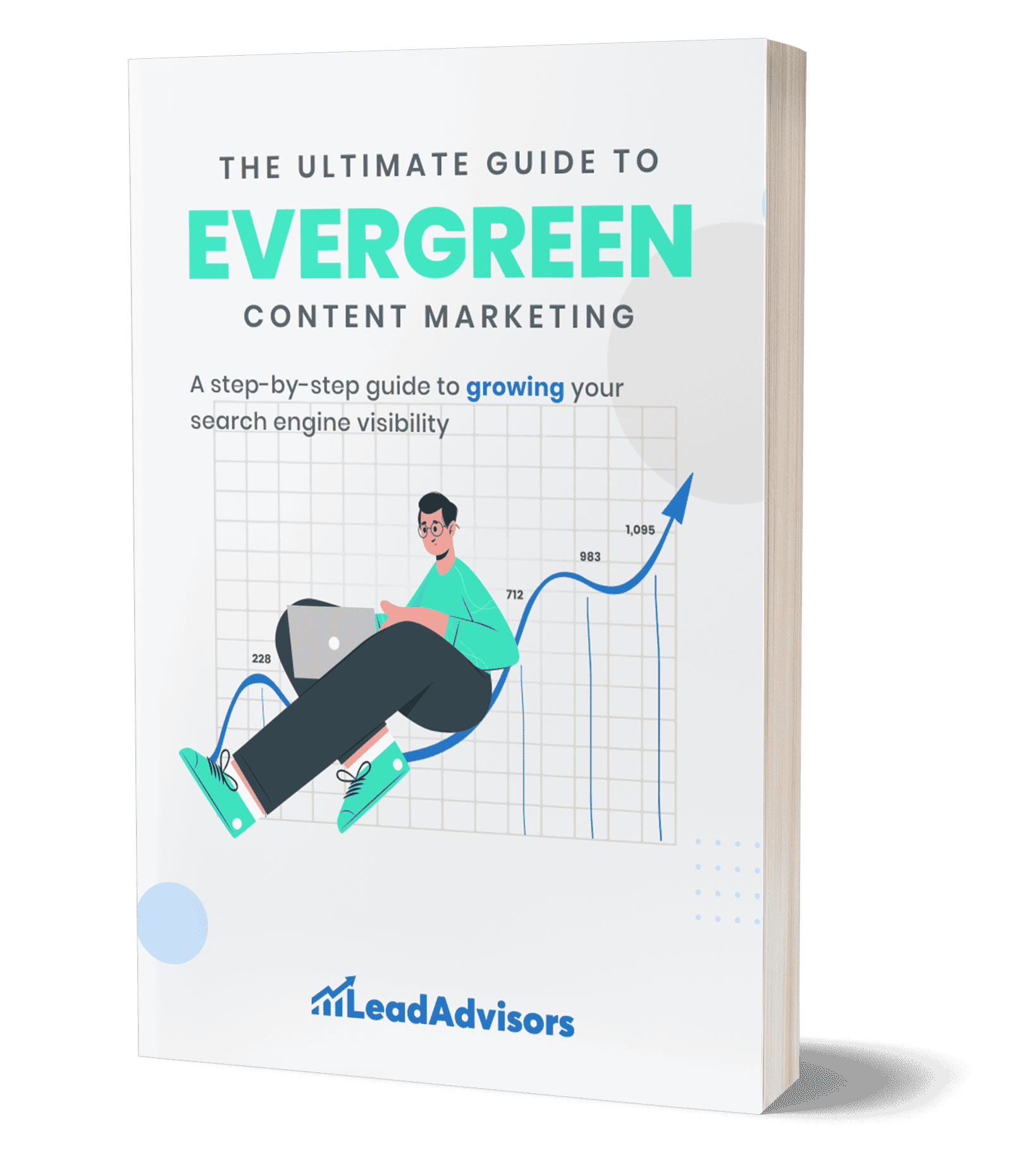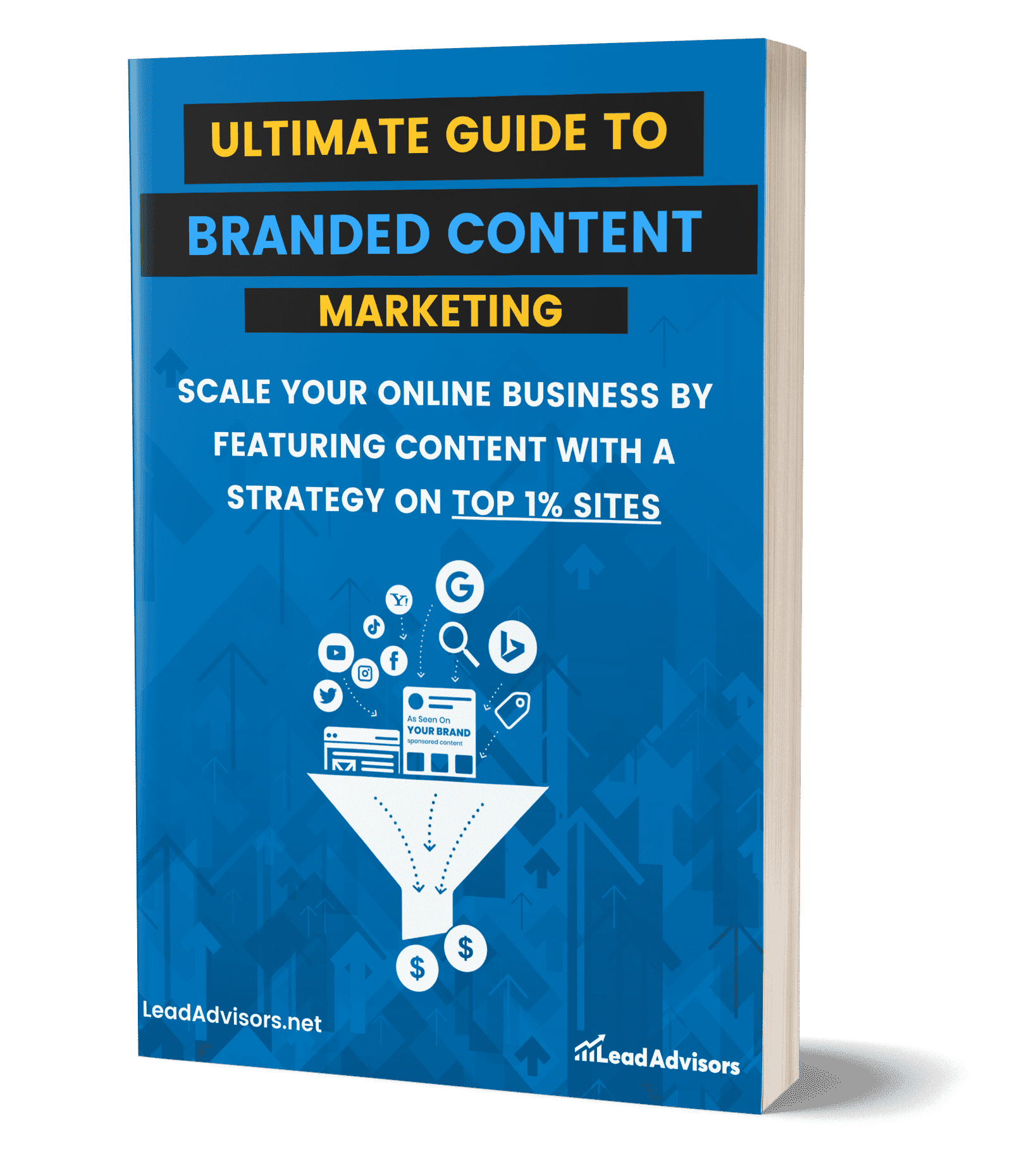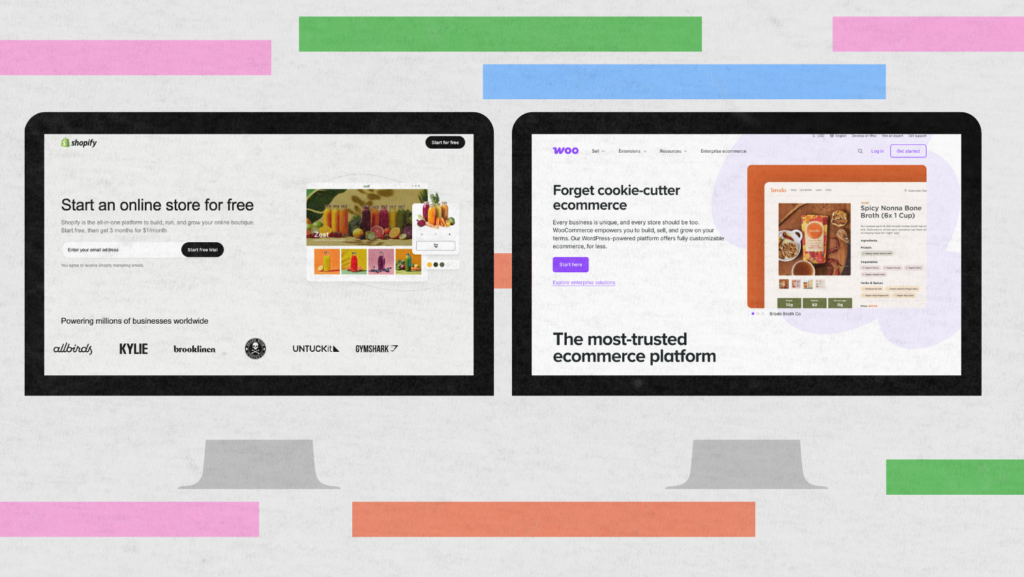Blogging is still very much relevant and is actually flourishing in 2025. To date, there are over 600 million blogs, and people cannot seem to find a better way than to use blogs to tell their stories, gain trust, and yes, make money online. AI hasn’t replaced human voices. The human voices have even got a bigger blogging platform through AI. Just consider the facts: the creator economy exceeded $250 billion in 2024, according to Statista. The main takeaway here is that people are still after genuineness and expertise.
In case the idea of turning what you love into something bigger has ever crossed your mind, then you are at the right spot. This manual is like a roadmap for you from setting up your blog, making it attractive, writing articles that people want to read, getting more followers, to making money from your work. You will learn how to be different, get in touch with your people, and create something that lasts.
Besides, you don’t have to concern yourself with programming. The only things you really need are some ambition, persistence, and the readiness to show yourself to the world. Let’s get your blog post up and running.
TL;DR (Too Long; Didn’t Read)
Blogging in 2025? It’s still one of the best decisions you can make if your goal is to share your thoughts, create a brand, or earn money online. Here’s the summary:
- Define your purpose: Are you doing it for the fun of writing, to make some money, or maybe both?
- Pick a niche: Select a topic that you really love and that people are looking for. This combination makes it interesting for you and helpful for your readers.
- Set up your site: WordPress.org would be the best option for you here. Get good web hosting and pick a theme that is nice and simple.
- Create quality content: Write helpful content. Make sure they are search engine optimization-friendly. Keep doing it, every week.
- Promote your blog posts: Let people see what you have done by using social media, quickly becoming a member of blogging communities, and starting your email list.
- Monetize: When people come, make that traffic work for you to have an income. Google AdSense, affiliate links, digital products— there are a lot of options.
- Stay consistent: Keep old posts updated, look at your stats, and always be open to learning new things.
Essentially: Be aware of your “why,” give genuine value, and don’t stop. That’s the way you create a blog that really lasts.
Define Your Purpose & Vision
Before you dive into selecting colors or looking for the perfect domain name, pause for a moment and ask yourself: Why do I want to start a blog in the first place? Perhaps you are really passionate about a topic and simply cannot wait to share your knowledge with others. Maybe you are looking for an extra source of income, or you want to position yourself as a leader in your industry. Or, maybe it is just about finding your people – those who care about the same things as you do.
Whatever your reason is, make sure you understand it. Your purpose? It is like the spine of your entire blog post. Aim at some concrete targets for yourself, like earning money through affiliate links, growing a loyal audience, or becoming the leader in your niche. Think of what success means to you. Would you like to have influence? Get recognized? Have a stable paycheck? Simply help people? Just say it.
There are more than 600 million blogs globally, which indicates how big the blogging world is. Nonetheless, successful blogs usually have a clear mission and reason for existence other than simply going viral. The blogs that survive are those that are started by genuine motivation, not just a pursuit of free stuff or viral hits. If the purpose of your own blog post is aligned with what you care about, then it will not be just another website. It will be your own place to evolve, produce, and make a real difference.
Pick Your Blog Topic & Niche
Choosing a niche for your blog post is not only the first step — it is a huge one. You want that perfect spot where your knowledge, your passion, and people’s interest all intersect. So, ask yourself: What is it that you could write about for hours without losing interest? What issues do you understand, maybe even better than others, without having to explain? When you figure out your focus, it becomes so much easier to get the right readers and create real authority.
Do not go ahead without confirming that there is real demand. Conducting keyword research and looking at what bloggers are doing is a good start. Google Keyword Planner, Semrush, and SpyFu are some of the tools that can give you insight into the searches people do. Take a look at Reddit or Quora to find out which questions are asked the most and what problems people have that need solving.
So, how is your angle different? Perhaps you expose facts that no one else does, you provide evidence for your claims through data, or you just have the knack of making things personal. Station points that are always relevant to your niche — like guides and how-tos — and also publish that trendy topic now and then. This way, your blog post will not only remain up-to-date, varied, and well-optimized for search engines but also will be in a good state to be there in the long term.
Choose a Blog Name & Domain
The name of your blog is like your first meeting with a new person. It shows what you are about even before the actual visit. Pick a name that is short, simple, and that people can easily remember. If the name you wanted has already been taken, try to come up with a new one—change it, add a word, or put a dash, just keep it as a click-worthy and as a nice reflection of your blog’s focus.
After coming up with a few good names, check if the domains are available. It is very easy to do this part with registrars like Namecheap, Google Domains, or Bluehost. A .com is still the most attractive one—people remember it, and it is the one that most people trust.
What your blog name is can be thought of as your identity on the Internet, something that can develop with you in the future. The right name is what basically sets the tone, whether you are dreaming of making money, gaining trust, or simply sharing what you love. Don’t rush this step. This is actually your real blogging starting point.
Get Your Blog Online
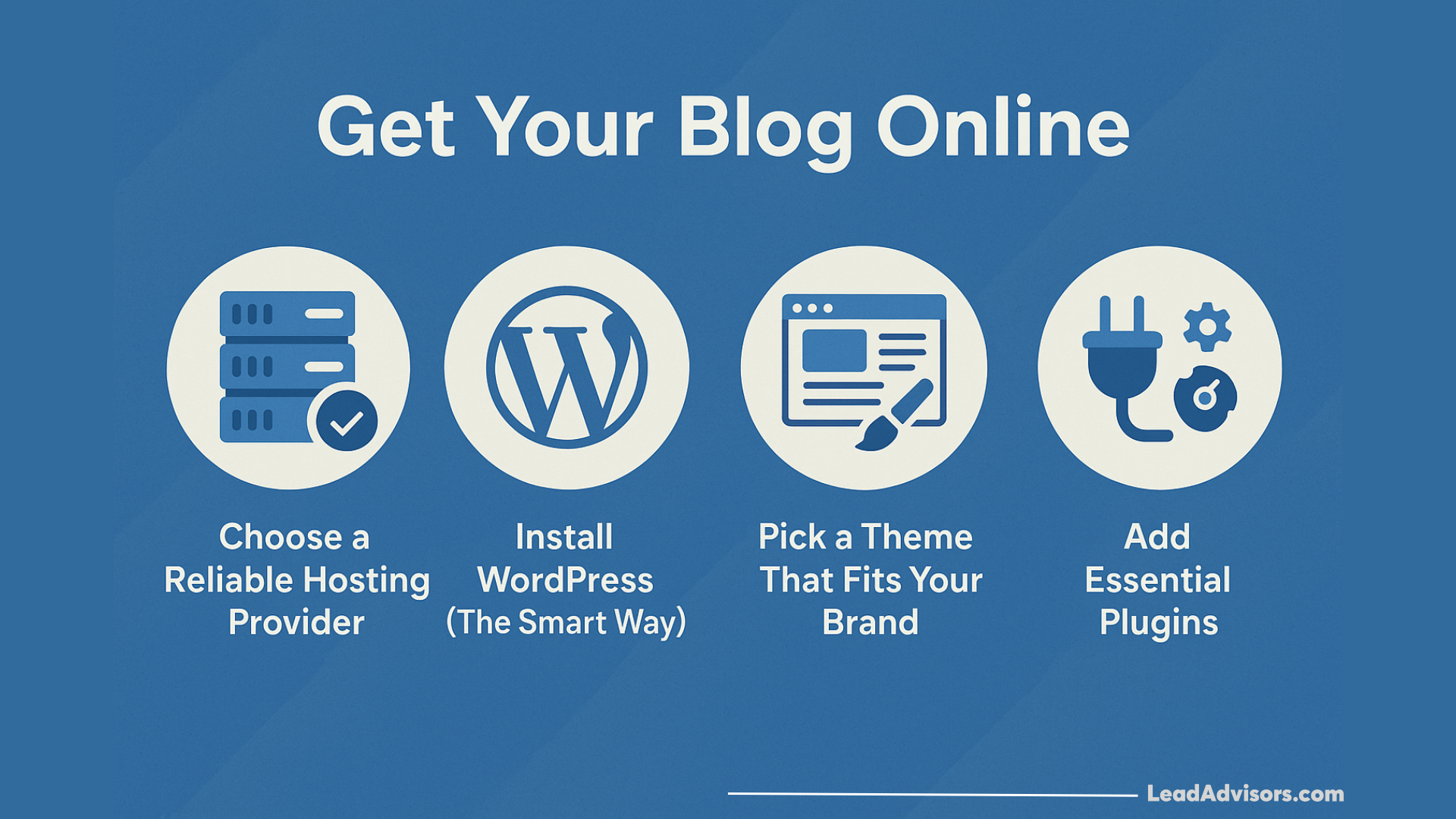
Alright, this is pretty much where things go from idea to reality. You had the concept—now it’s time to actually publish your blog post on the web. If it’s too much of a concern that this part will be hard for you to understand, then you perhaps need to calm down and have a rest. It is much simpler than it sounds. A good setup breathes life into your idea, which might just be a note on your phone, and in no time at all, your site is live.
1. Choose a Reliable Hosting Provider
Your hosting provider is basically the home of your blog. It should be one that is reliable – no one wants a blog post that is always down or slow. Typically, I would suggest Bluehost or SiteGround to people. They are not only quick and dependable but also very user-friendly for beginners. Moreover, it does not take much effort to use most plans because they offer a free domain, which is a small discount that you get right from the start.
It’s a matter of a few clicks to link your domain, set up WordPress, and get online. Whether you’re blogging to make money or just for fun, good blog hosting means your site runs smoothly from the very first day.
Read more about Webflow vs WordPress (2025): Which Website Builder Is Better?
2. Install WordPress (The Smart Way)
It’s confusing for you. What is the difference between WordPress.org and WordPress.com? Just select the self-hosted WordPress.org option. The reason is that you have the liberty to control everything-design, content, and even the way you use to make money. WordPress is very adaptable, so you can create your website in any way you want.
Besides, by using a self-hosted WordPress blog, you can put advertisements, affiliate links, and get sponsorships. Most professionals and business owners do so is their preferred method, but it is equally effective for newcomers.
3. Pick a Theme That Fits Your Brand
Your WordPress theme determines the entire atmosphere of your blog post. You need to have a theme that is not only neat but also fast and user-friendly. Just to name a few, the themes Astra, GeneratePress, and Kadence are equally good—they are attractive on mobiles, you can modify them to an unlimited extent, and they are designed to help you be found in search results.
A well-built WordPress theme allows you to attract people’s attention and thus make your money blog look as if it really is a natural part of your niche.
4. Add Essential Plugins
Plugins are what turn a basic WordPress blog into something powerful. Here are a few you’ll want from the start:
- Yoast SEO or Rank Math – for search engine optimization
- WP Rocket and Imagify – for speed and performance
- Wordfence – for site security
- UpdraftPlus – for automatic backups
- Google Site Kit and Cookie Notice – for analytics and compliance
These plugins handle the behind-the-scenes stuff so you can spend more time actually writing and connecting with your readers. That’s what really counts.
About WordPress (Technical & Workflow Foundation)

Your WordPress blog is active and live. What now? It is time to really get familiar with the tools that will make your blog post attractive and stand out. WordPress is, in essence, the one place where you can use your creativity and still have the options to design, write, and manage your content right from there.
Master the Block Editor (Gutenberg)
The first thing to be done is to get familiar with the Block Editor, which is also called Gutenberg. With this tool, you can more easily write and arrange your posts. Blocks are used here—each block could be a paragraph, an image, a list, a button, or any other thing— and you can move them around the way you like.
It is a lot more flexible, and after you have mastered it, you will find that you use blocks more and you keep your style more consistent for each of your posts. Moreover, you can use free images or videos to make everything visually attractive.
Use Schema-Ready Structures
After that, we should focus on the article structure. WordPress is equipped to handle schema markup for different things, such as FAQs, reviews, and how-to guides. This is enormously important for SEO. Once you introduce the structured data, it becomes very easy for search engines to understand the content of your posts.
Consequently, your posts have a higher chance of being displayed in the featured snippets and thus always being ahead of those AI-powered search results. For example, search results enhanced with rich snippets receive 58% higher clicks compared to standard results.
Streamline Your Editorial Workflow
Whether you are the only one who manages the whole situation or you have a team that you work with, WordPress makes the collaboration process easy and less complicated. You are able to set up roles, view the different versions, and even schedule the posts that are not yet published. Your editorial calendar will be very well kept, and you will always know what is coming up next.
Integrate Essential Tools
Make sure that you make use of the right tools. You can integrate things such as email signups, push notifications, and analytics right into your dashboard. If you are to want to make your site faster, you should give a try to WP Rocket and Imagify.
What you need to do is just install your most liked SEO plugin, and then you are free to play with SEO as much as you want. There are tools like CoSchedule, which can assist you in planning your articles, and Grammarly, which can be your writing style guide and linguistic errors fixer.
Follow a Simple Publishing Checklist
Before you hit publish, review this checklist carefully:
- Finalize your draft and table of contents
- Add visuals, FAQs, and free images
- Optimize headings and metadata
- Interlink with relevant posts
- Submit for indexing and refresh regularly
Once you have mastered this workflow, you will no longer be a casual blogger but rather a tightly run professional. This is the way you keep your blog post evolving and alive over time.
Customize Your Blog Design
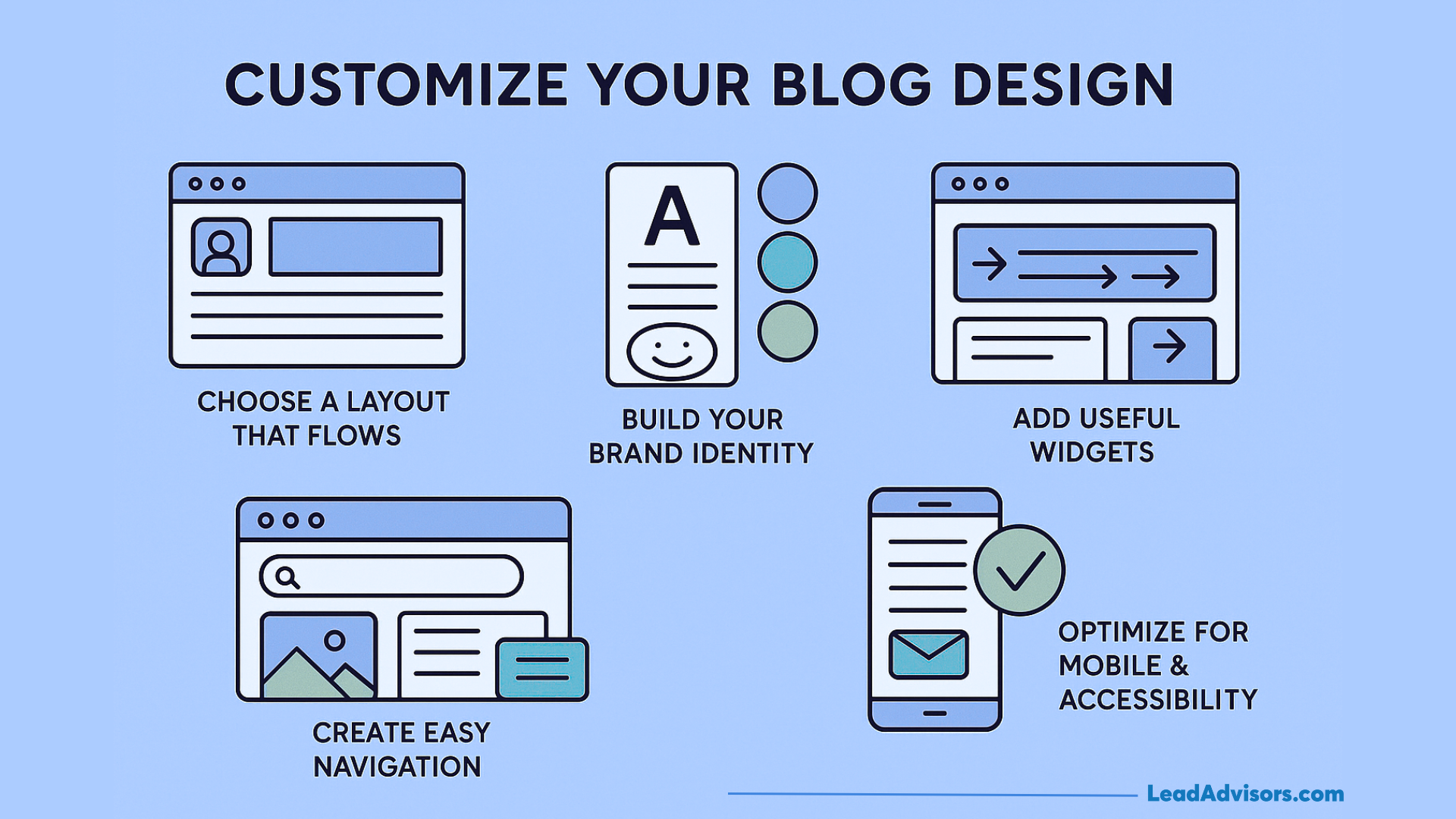
Your WordPress blog is up and running. Now it’s time to have some fun – making it your own space. A good-looking blog doesn’t just attract visitors; it also holds their attention and makes them come back. The layout, colors, and structure you decide on? They should not only indicate your style but also make it super easy for people to navigate.
1. Choose a Layout That Flows
Firstly, sketch out the main pages of your site. You are going to need a clean home page, a dedicated blog section, an “About” page telling people about you, and a way for readers or brands to get in touch. These essentials guide visitors through your site and distinguish you from the rest of the blogging community.
2. Build Your Brand Identity
Consider the design of your blog as your unique online signature. Select fonts that mirror your character, decide on a color palette that harmonizes, and create a simple logo that people can easily recall.
Visual elements like logos and colors significantly impact brand recognition—consumers are 81% more likely to remember a brand by its color than by its name, and 75% recognize a brand primarily by its logo.
Don’t forget the favicon – that little icon in the browser tab. It’s what makes your site recognizable. For visuals, use free, high-quality images from Unsplash or Pexels. They’ll elevate your successful blog without you having to pay for it.
Read more about Visual Identity: A Guide for Social Media Success
3. Create Easy Navigation
Have a top menu with links to your main pages, and put quick links—like policies or contact info—in the footer. In case you are providing services or digital products, don’t forget to add a page for them as well. When navigation is simple, users have more faith in your blog and enjoy reading your content more.
4. Add Useful Widgets
Widgets make your successful blog the best it can be with minimal effort from you. Add a search bar so that visitors can find what they want quickly. Let people know about your latest posts. Be sure your comments section is available if you want people to talk, and add a newsletter signup to expand your email list.
5. Optimize for Mobile & Accessibility
Today, tablets and smartphones are the top choice for reading blogs. Your site, therefore, must be attractive and functional on any device. Opt for a responsive blog template, ensure that there is enough color contrast, provide alternative text for your pictures, and use legible headings. Accessibility is important – your content should be consumable by everyone.
Ultimately, successful blogs with a neat design that is functional on any device users have are the ones visitors keep coming back to. Keep modifying your design as you keep writing and creating content. The best blogs not only stay with their creators but also evolve and change just like them.
Publish Your First Content
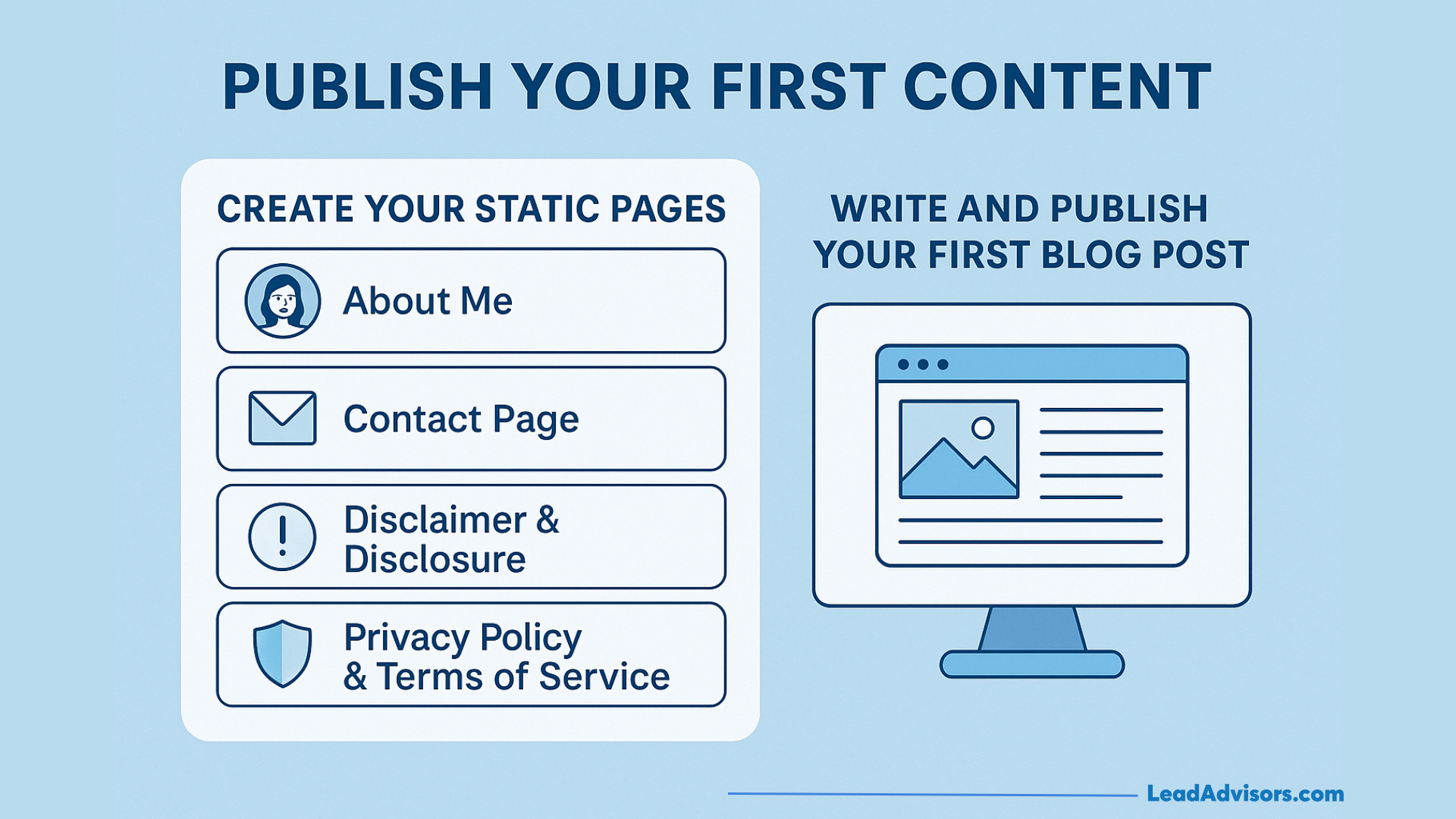
The status of your blog sounds very positive. Then comes one of the most exciting parts – stuffing the blog with original content that reveals not only your personality but also the purpose of the successful blog. View it as your major ‘hello world’ to the realm of the internet. However, before you immerse yourself in writing complete articles, it’s better to prepare a few key pages that will serve as the foundation of the site.
Create Your Static Pages
Besides interesting posts, there are some essential pages that every successful blog should have. These pages serve the purpose of generating trust and making the blog appear transparent to visitors:
- About Me: This is your chance to tell your story, let the readers know your background, and explain the reasons that led you here. At this point, the readers get to know you.
- Contact Page: Enable anyone—readers, potential partners, or brands—to contact you in a very easy way.
- Disclaimer & Disclosure: In case you have affiliate links or sponsored posts, don’t hesitate to tell people about them. Apart from the honesty factor, which is very important, this also ensures that you comply with the FTC rules.
- Privacy Policy & Terms of Service: Users are always interested in the security of their data, and these pages are also required by search engines.
Your audience will see you as a reliable source, and so will the search engines. The pages mentioned above play a significant role in establishing this trust.
Write and Publish Your First Blog Post
After setting up the essential pages, you are ready to write your very first post. Writing a post on a topic that comes naturally to you would be the best option, e.g., sharing your personal experience, writing a short guide, or simply introducing your successful blog and its purpose. Don’t forget to include an attractive featured image, create some alt text for the visually impaired users, and use proper headings that make it easier for the readers to skim your post. Also, a few links that direct the readers either to your website or to other valuable sources will add more value to your post.
If you are happy with the result, then put it live. That’s all. Your first post is out there, and you’re officially off the ground.
Write Killer Blog Posts (The Side Blogger Framework)
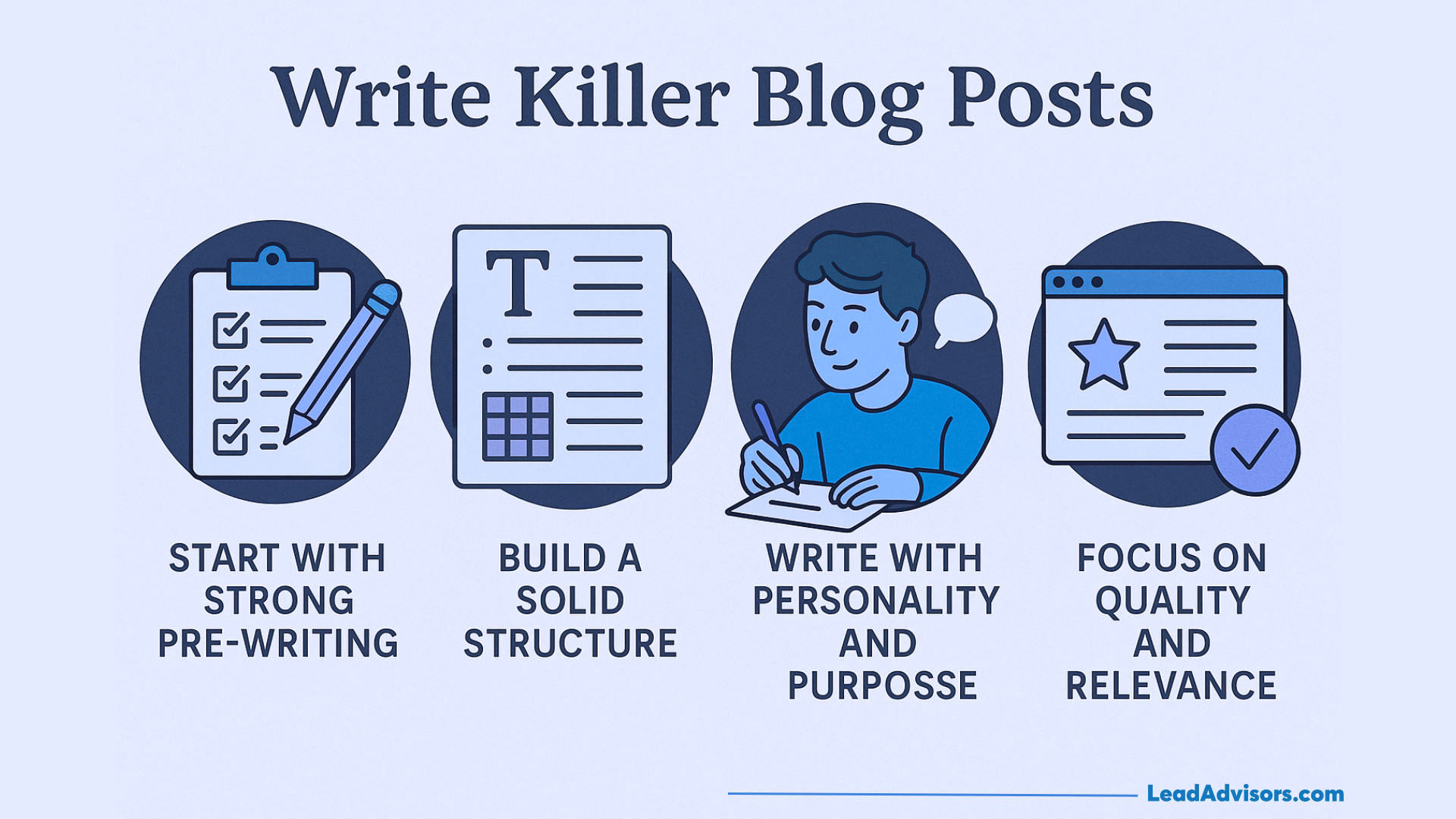
We all know that the main factor that distinguishes a blog that gets traffic from a blog that is lost in the vastness of the internet is nothing but the content of the successful blog. Your posts should not be mere fillers of the page—rather, they have to teach, provoke thinking, and make a bond with your readers. Side Blogger Framework is my answer to that problem. I cannot imagine a blog post that does not follow this step-by-step process to schedule, write, and edit a successful blog post that is helpful and gets traffic.
1. Start with Strong Pre-Writing
Every piece that can be called a post is basically something that is already done before you even touch the keyboard. Go through existing content, ask people, or use tools like Google PAA, Semrush, and SpyFu to find out common questions and competitors’ behavior.
After that, find answers to these questions: “What’s the main point of this article?” and “Who would be interested in it?”. Such a quick and simple test of your intuition saves you from the trap of aimless writing while losing sight of the problem.
2. Build a Solid Structure
My reliable structure is always at my disposal in case I want to write a blog post capable of attracting more viewers:
- Outline – Get your thoughts in order.
- Compelling Title – Craft a title that grabs attention. I like using CoSchedule Headline Studio for this.
- Hooking Intro – Write an intro that pulls people in with a story, a surprising fact, whatever hooks them.
- Body – Break it up with sections, visuals, examples, lists—keep it easy to read.
- FAQ – Add an FAQ if you know readers will have questions.
- CTA – Push for a comment, a share, a sign-up—something.
- SEO Optimization – Check your SEO basics: titles, URLs, images, internal links.
- Edit – Edit for tone and clarity. Grammarly helps, but trust your ear, too.
- Publish + Content Upgrade – When you publish, add a bonus—a checklist, template, or something readers can download.
3. Write with Personality and Purpose
Storytelling and character are the things that readers relate to the most. Keep the tone of your writing like you are talking with a friend. Tell about your struggles and also your successes. Use examples that are more understandable to your readers. What the best bloggers have in common is that they don’t sound fake (which is very important), and thereby, they acquire the trust of their readers.
4. Focus on Quality and Relevance
Make the utility and topicality of a post your major concerns. Use trusted sources, include real data or graphics, and always ask yourself whether what you say is important. It is not only about the traffic you are bringing to your site; a powerful post will attract both readers and search engines and thus elevate your status.
The combination of a well-thought-out plan with your genuine voice will do much more to inform people than just inform. Actually, it will have a real impact on people. That is the way to build a blog that is not overshadowed by the competition, regardless of which niche you belong to.
Build Your Brand & Voice
Creating content is not the only thing a blog is about. Your character is the thing that really stays with people—your perspective, your style, your principles. Readers are not just looking for facts or tips; they want to have a relationship with the person behind the words. This is the main reason why your personal brand and voice are so important. These are the things people remember long after they have left.
Bloggers are 13 times more likely to see a positive ROI when they focus on consistent, high-quality content as part of their personal branding efforts. In fact, 80% of professionals believe content creation directly enhances their personal brand, leading to noticeably higher engagement rates and authority in their field. Studies also show that personal branding content can boost audience engagement by up to 60%, and users who engage with it are 70% more likely to remember the brand or individual.
So why not start from scratch? Consider the way you want people to feel when they visit your blog. Would you like to soothe them, excite them, or make them laugh? Choose a tone and a personality that correspond to your inner self. Be consistent with it—your colors, your logo, your writing style, even your little idiosyncrasies. This is what differentiates you from the others in the blogging world.
As your blog develops, continue to focus on what is important to you. Only advertise with brands or affiliate programs that you genuinely like. Stop pursuing follower counts and other such meaningless numbers—focus on being authentic and on providing quality. Always proofread your articles, make your visuals more attractive, and keep things neat and tidy. After all, people return to blogs that are genuine and well-maintained, not just another copy of the rest.
Launch Strategy
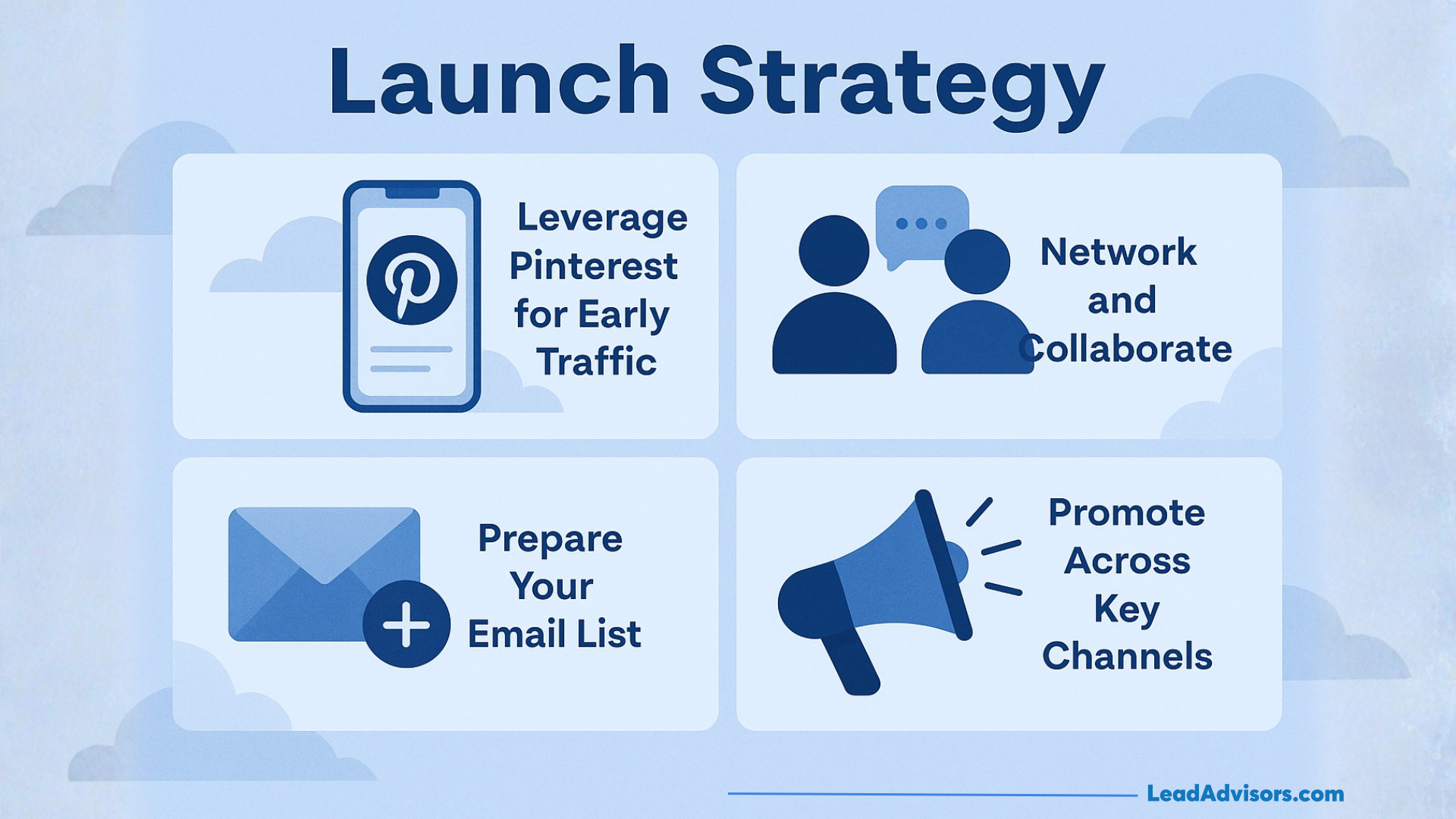
The design of your blog is on point, your first post is up, and you are ready to flaunt it. What’s the next step? People need to be aware of your existence. A well-thought-out debut plan attracts your target audience, creates some buzz for you, and prepares you for continuous growth.
Leverage Pinterest for Early Traffic
Initially, concentrating on the use of Pinterest would be a wise decision. Without a doubt, this blogging platform is one of the most efficient free tools for driving traffic to your blog. Before launching, keep your followers between 800 and 1,000 and create several branded pin templates by using Canva.
After that, you need to be active in your niche group boards and pin your appealing visuals along with the links to your website. If you do it properly, Pinterest will be your traffic source even after your launch.
Read more about Pinterest Marketing: The Ultimate Guide
Network and Collaborate
Waiting for people to come to you is not an option. Get in touch with other bloggers who are operating in your sector. Create a “Top 10 Resources” post in which you provide references to the creators or tools that you are fond of. Subsequently, email them to inform them of their being featured. Many of them will repost your content, thus leading to an increase in the number of people who see your blog.
Prepare Your Email List
You should get your mailing list in shape prior to launching. Organize your mailing endeavor and come up with 2 to 4 lead magnets, maybe a checklist, a mini-course, or a useful template. Free, handy stuff is what people love, and this tactic allows you to develop your list from the very beginning. Furthermore, you are building a community that genuinely cares about what you are saying.
Promote Across Key Channels
Inform as many people as possible about what is going on, and the channels you can use for that are numerous-Facebook groups, newsletters, a soft launch with friends, or colleagues. Don’t just drop links; instead, be active in discussions, give genuine advice, and collaborate when it is appropriate. The greatest promotion is achieved when you concentrate on building relationships rather than just increasing your numbers.
Basically, a clever announcement of your existence is not just about saying “Hey, my blog is here!”; rather, it is about demonstrating to the world that your arrival can not be overlooked. By following certain steps and showing a bit of your character, fans and readers will come to you from the very start.
Read more about Content Syndication: This is How to Reach a New Audience
Grow & Promote Your Blog
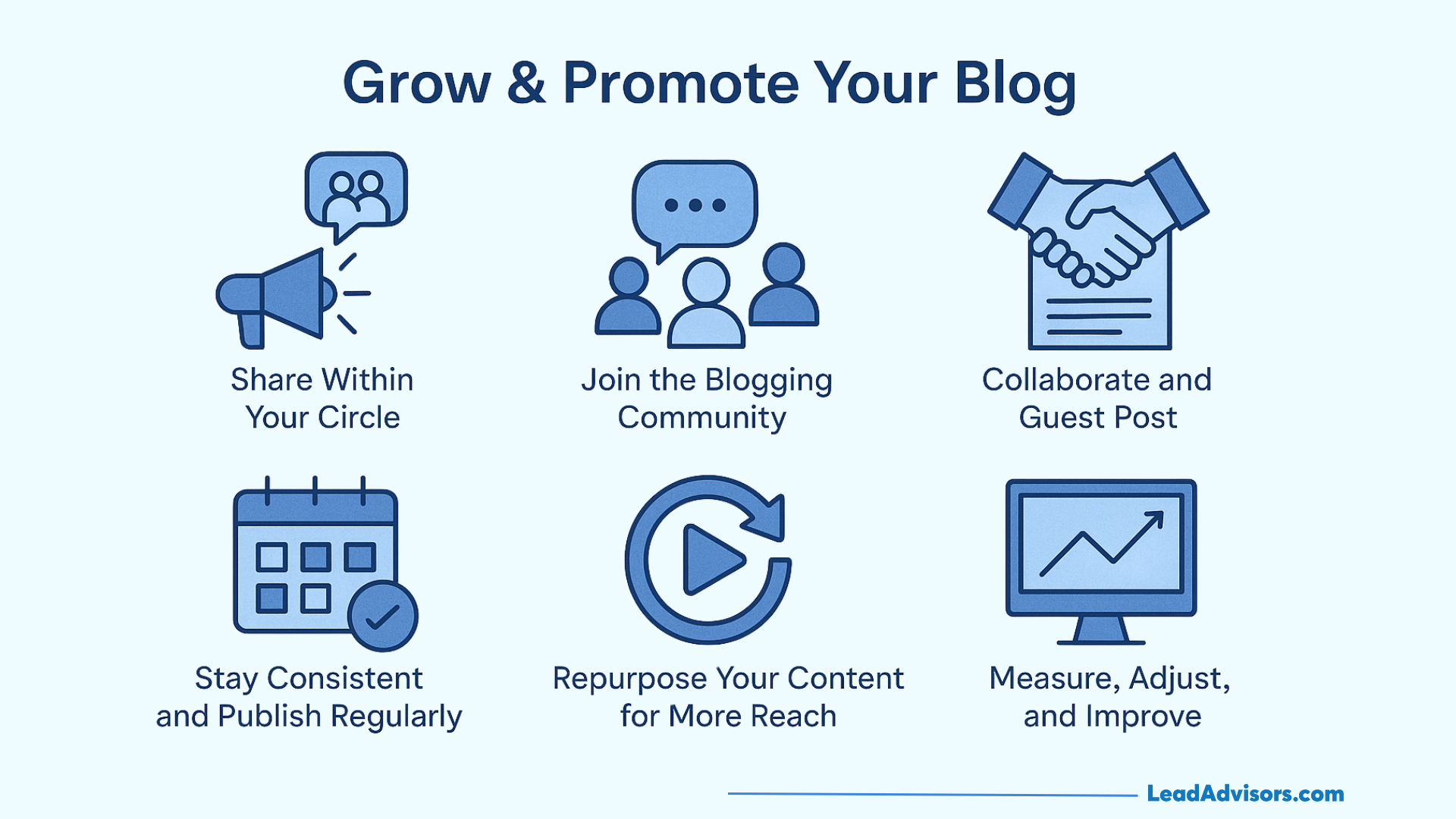
The launch of your blog is merely the beginning. What follows is the real challenge: getting readers to read the stuff that you have written. Your blog should remain visible, appear in the right places, and, of course, keep readers coming back. This is how.
1. Share Within Your Circle First
Your first users can become your most loyal supporters.
- Do not hesitate to share the content of your blog with the people you know: friends, family, and colleagues.
- Tell the world on your social media that your work is live.
- By soliciting feedback, you get more people (readers) involved in sharing their thoughts, and this, in turn, facilitates their participation in the work of spreading your creation.
Why? Simply because the search engines will notice the life and the activity of your newly launched blog.
2. Join the Blogging Community
Interacting with fellow bloggers not only exposes you to other audiences but also helps you to build enduring bonds.
- Engage in discussions in groups/blogging-related forums on sites such as Facebook, Reddit, or Quora.
- Make your presence known through comments on the blogs you follow in your field.
- Provide value by giving some blog post ideas for collaborations or guiding the communication without marketing your product.
Participation and presence in the blogging community is truly a straightforward path to free growth.
3. Collaborate and Guest Post
By sharing your articles on other blogging platforms, you get visibility and SEO ranking benefits at the same time.
- Submit articles to the websites that are already popular and well-established in your field.
- Get other bloggers to write for your site and share the content to broaden your reach.
- Agree to perform interviews, write listicles, or create resource roundups together.
The audience and authority of your blog will grow with every new connection.
4. Stay Consistent and Publish Regularly
Determining a realistic routine will not only help you keep your promise to yourself but will also generate a certain momentum.
- Try to publish 1–2 blog posts every week so that the readers will not forget you.
- Topic planning with the help of an editorial calendar is a great habit.
- Before publishing your article, make sure the on-page SEO is up to standard by using plugins such as Yoast SEO or Rank Math.
If a blogger keeps on publishing regularly he/she will be able to grow faster since both readers and search engines will consider the blogger to be of high quality and reliable.
5. Repurpose Your Content for More Reach
One of the best ways to accomplish your goal is to divide one article into several other types of content.
- You can make short videos of your tips on YouTube or TikTok.
- Creating infographics or Pinterest graphics with the help of Canva is also a great idea. Here are some Canva alternatives for more options.
- Make use of your email marketing campaign by sending out snippets and insights.
That is to say, by multiplying rather than doubling your work, you are increasing your reach.
6. Measure, Adjust, and Improve
You should always have a good look at your figures if you want to grow successfully.
- Google Analytics 4 is a great tool to find out where your visitors come from and what they do on your site.
- Google Search Console helps to monitor the number of clicks, impressions, and the performance of keywords.
- Find out which articles are the most visited and do more work in that style.
By being energetic, regular, and data-oriented, your winning blog is going to keep on growing—bringing in new followers, increasing your ranks, and, as always, establishing trust further with each new post.
Evergreen Content Strategy
The growth of your successful blog over a long-term period depends on your focus on creating content, mainly the posts that stay relevant over time. These are basically your how-to guides, tutorials, and the main sources that keep attracting readers from search engines year after year.
Why Evergreen Content Matters
Evergreen pieces deliver continuous value through steady traffic, backlinks, and passive income from affiliate links or ads. They become your blog niche authority and thus, your site is recognized as a trusted resource way beyond the time of publishing.
Best Evergreen Formats
- Resource hubs (“Everything You Need to Know” guides)
- Step-by-step tutorials and comparisons
- Yearly updated cornerstone posts
These formats are the ones that make your blog content relevant and have more chances of being shared.
Keep It Fresh
Just update your posts lightly every quarter—change data, links, and visuals. You should also do a thorough revision every year to keep up with SEO and user trust.
Link and Track
Put internal links pointing from your new posts to your evergreen hubs in order to uplift SEO. You can keep an eye on performance using Google Analytics 4 and Google Search Console to be updated on traffic, rankings, and conversions.
Evergreen content with regular updates and intelligent linking makes your blog a long-term, traffic-generating asset that gets more powerful each year.
Monetize Your Blog
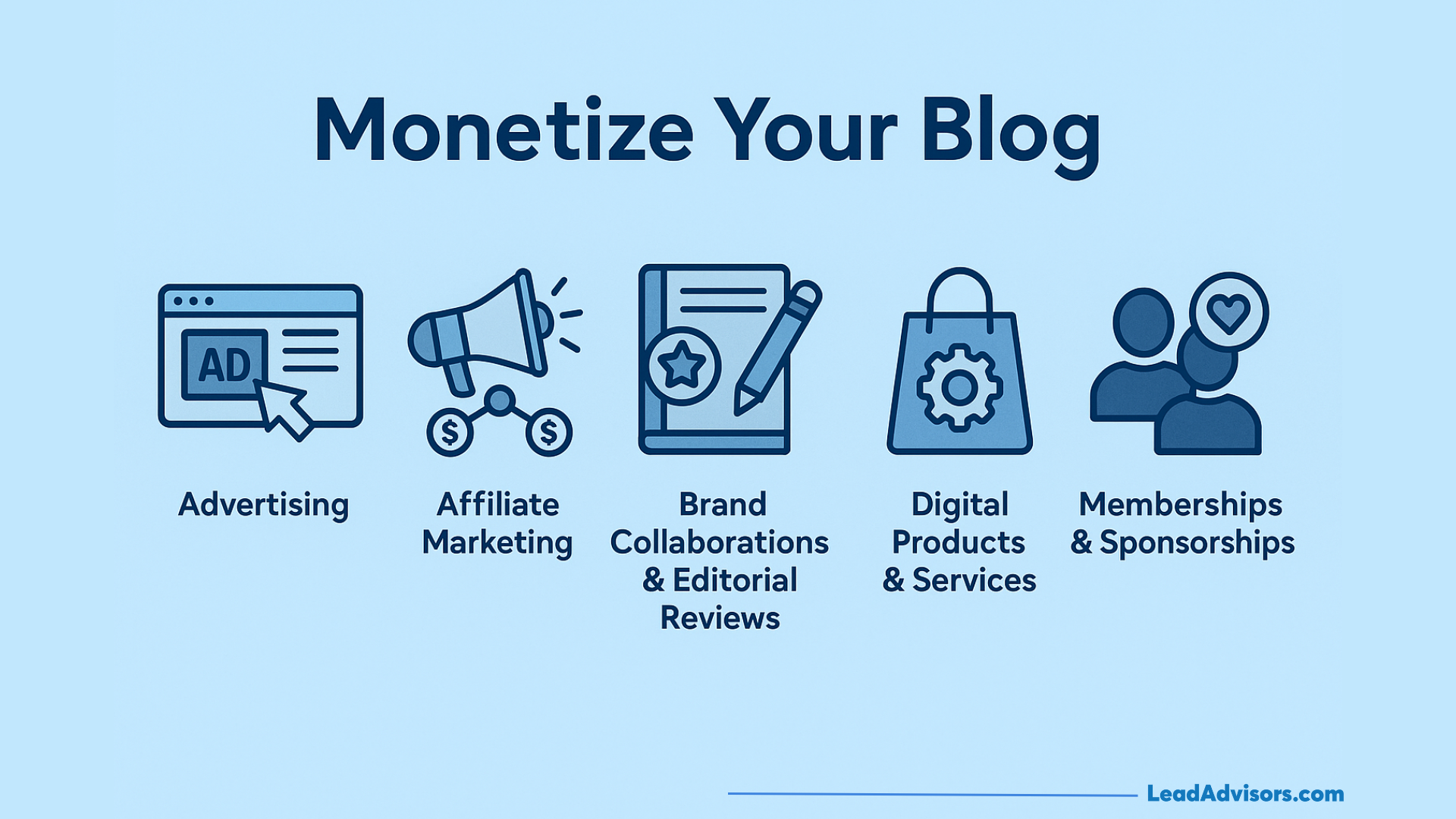
How about making money out of your blog? Your blog is already getting a lot of attention and traffic with the readers you need, and now it’s time to make money out of it. The good thing is, making money out of your blog does not necessarily mean that you have to lose your voice or your principles.
Advertising
Simply put, Google AdSense or Mediavine are the most popular choices for ad networks for good reasons. They are the ones who manage the ads while you get the money from the clicks or views.
However, once your figures are up, you should consider communicating with the brands directly. In general, sponsorships give you more money, and you also get more freedom as to what content will be published on your site. In other words, you are still the one who is in control.
Affiliate Marketing
There are many benefits of having affiliate programs for bloggers. Explain What Things Are and What Uses They Have; Writing Product Reviews Based on Real Usage, Comparisons, Top 10 Most Used Lists, Etc. Just don’t forget to place an affiliate disclosure for transparency. Your eyes should be on clicks, conversions, and recurring commissions. This is an actual earning, and you can help your readers by giving them the products you trust.
Brand Collaborations & Editorial Reviews
We at LeadAdvisors have realized that brands get collaborations most with those bloggers who create credible long-form content. As a result, you are able to:
- Obtain a feature in prestigious publications
- Be the first to offer Evergreen Editorial Guides or “Best-Of” listicles, receiving continuous traffic
- Help readers to decide by presenting well-balanced pros and cons
- Track backlinks, impressions, and conversions to demonstrate ROI
These tactics transform partnerships into consistent income streams for the future.
Read more about Native Advertising or Affiliate Editorial Reviews: Which Suits Your Brand Better?
Digital Products & Services
If you have knowledge, then market it. Whether it is an online course, an eBook, templates, or consulting, if you are an expert, then just create a package of it. This not only gives you new ways to make money but also helps you establish your brand in your niche. It is an expandable business model, and you decide on the terms.
Memberships & Sponsorships
Once you have made a community, you can offer memberships or simply ask for donations. Email sponsorships are another way through which you can get regular income. Deliver exclusive content that is a real reward for your most loyal readers. That’s how you both grow your brand and keep followers coming back.
The bottom line is that if you are clever enough, you are able to transform your blog from a leisure activity into a flourishing business without losing what made it unique in the first place.
Track Progress & Adjust
Blogging success is not a matter of a single night. Success comes to every blog that is grown by steady improvement, data tracking, and regular optimization. Essentially, understanding what is effective and not, and adjusting your strategy accordingly as your audience and goals change, is the key.
Set Realistic Milestones
The natural progression of most new blogs is an initial curve of growth:
- 6 months: Early traction—expect a few wins and loyal readers.
- 12 months: Steady traffic and measurable engagement.
- 2–3 years: Sustainable income and brand authority (Reddit community insights).
Progress is a matter of time—patience and consistency will serve you well.
Track Key Metrics
KPIs should be used as a yardstick for growth:
- Organic sessions and page views
- Email subscribers and engagement rate
- Conversion rate and Domain Authority (DA) growth
By using tools such as Google Analytics 4 and Google Search Console, you can get to know your blog audience and be in a position to know which posts give the most outputs.
Audit Regularly
Each quarter, you should take a look at your site for:
- Content gaps and underperforming posts
- Broken internal links or outdated information
- SEO refresh opportunities
By performing regular audits on your own blog, you will be able to keep traffic at a good level, enhance SEO, and ensure that your content is in line with the needs of your readers.
Tracking and adjusting is not simply upkeep—it is the way your blog becomes a brand that lasts and generates income.
Legal, Compliance & Trust
To get users or brands to trust your blog, you must not hide how things operate behind the scenes. People are attentive to the manner in which you handle their data, partnerships, and the money, if any, that you make from content. Therefore, do not omit the essentials.
You can launch with these important pages:
- Privacy Policy: Indicate the data, cookies, and analytics usage in detail. It is also important that you follow regulations such as GDPR and CCPA.
- Disclaimer: If you have affiliate links or sponsored posts, inform us. Also, insert an educational disclaimer just for the sake of clarity for everyone.
- Terms & Conditions: Explain how the users can access your site, what belongs to you, and in what ways your content can (or can’t) be shared.
Inform visitors through a cookie banner about what is being tracked and the reason for it. Also, if you are releasing a sponsored post or any monetized content, a brief disclosure can be placed just above or below the post.
All these things are not only about your legal protection. They are a demonstration to people (and to search engines) that you value honesty, professionalism, and doing things the right way. That is what really creates trust.
Tools & Resources (Recommended Stack)
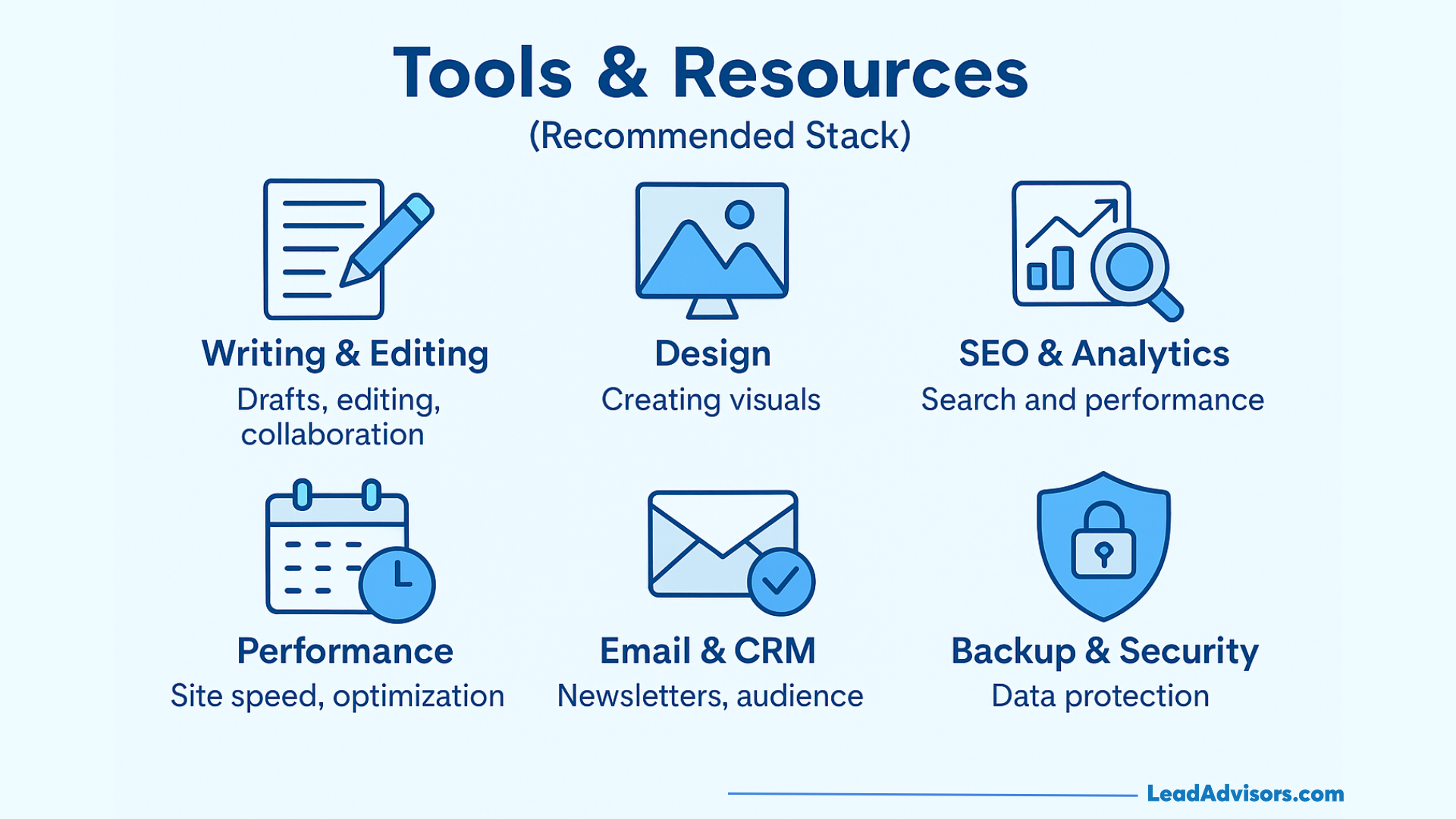
Blogging would be way more complicated if you didn’t have the proper tools. Honestly, the right equipment might save you from wasting several hours, and at the same time, it will enable you to put out your best work. Besides this, you would not have to be concerned about the small stuff. What I use to help me stay organized, efficient, and professional is the stack of tools below.
Writing & Editing
- Drafts, editing, and collaborating with other people are the main things I do in Google Docs. It simply works.
- Grammarly and Hemingway correct, edit, and rewrite your text. They also make your writing look professional and natural. Your readers will definitely notice.
Design
- Canva and Adobe Express are great for producing visuals. Blog headers, Pinterest pins, infographics—whatever you need to make your new blog content pop, these tools make it easy, even if you’re not a designer.
Scheduling
- CoSchedule, Tailwind, and Planoly are the tools you need to keep your social posts and blog posts on a schedule. Doing it, forgetting it, and then seeing your blog develop as you keep creating is the idea.
SEO & Analytics
- You can control SEO with the help of Yoast SEO or Rank Math right from your WordPress dashboard.
- Use Semrush and SpyFu to find keywords and see what your competitors are up to. See our guide about Semrush Alternatives 2025: Free, Paid & AI Options.
- Google Search Console, together with Google Analytics 4, is a must if you want to be able to track your website visitors and understand what is working and what is not.
Performance
- WP Rocket, Imagify, and Cloudflare CDN are the tools that make your website fast and easy to use on any device. A quick website ranks higher, and visitors stay for longer periods.
Email & CRM
- ConvertKit, Beehiiv, or MailerLite are the tools you need to build your email list and to send newsletters to your supporters directly. Exclusive content, new blog posts, promotions — you get more loyal readers, and they get more value.
Backup & Security
- UpdraftPlus and Wordfence are the plugins that take care of your blog and keep it safe. They defend your blog against hacks, crashes, and those moments when things go terribly wrong.
In truth, being equipped with the right tools is not only about the aspect of time-saving—it also provides one with mental ease. Rather than doing the work of solving problems, you will have more time for writing, interacting with people, and growing your blog. That is what really matters.
Sustainability & Scaling
So, your blog has been getting more and more attention. You have steady traffic, and you are making some real income. Now comes the difficult part of keeping it going and also making sure that you do not burn out during the journey. At this point, you are no longer just a blogger, but you are running a business. This entails changing your approach by working smarter, growing your community, and really making a difference over time.
Start by examining the things that take up a lot of your time. Editing, design, SEO, and all the other work that goes on behind the scenes. Get someone to do it for you. Hire freelancers or virtual assistants who will be able to do those tasks, and thus, you will be free to use your energy for what actually brings results: strategy, partnerships, and content creation that you are glad of.
Repurpose and reimagine your top content. Make them into eBooks, newsletters, video scripts, or whatever is suitable. Thus, you will be able to connect with more people and demonstrate your expertise once again, only in a different way.
Your community is also very important. Create an environment where your readers can have access to you and also communicate with each other, perhaps on Discord, Substack, or Patreon. Give them something that is only for them and that makes them feel comfortable. The real feeling of being a part of something is what makes your growth more stable.
Always be eager to learn. Keep looking for changes in SEO, try new AI tools, and see what other bloggers are doing. Also, do not think all the time in only one way. Consider affiliate programs, digital products, coaching, i.e., multiple streams of income, will be the reason why your blog will still be expanding even when you are not working.
To sum up: scaling is not about doing more tasks at once. Rather, it is about finding better ways of accomplishing what is important. Arrange the proper systems, and your blog will not only survive, it will thrive.
Frequently Asked Questions
How to start a successful blog from scratch?
How to start a successful blog and make money?
How to start a successful blog for beginners?
How to start a successful blog business?
How can I start a successful blog to earn money?
Conclusion
To sum it up, let’s be honest—creating a blog that actually functions takes a lot of time. One must have passion, keep coming back to the work, and have a plan that makes sense. No one gets a big audience or a pile of money from their very first post. Every successful blogger you can think of was small at the beginning, made mistakes, tried new things, and didn’t give up. The things you write now? That’s what will bring you future readers, real income, and maybe a little bit of influence.
In case you are still waiting for some perfect signal to start, don’t wait. This is it. You already know how to start your blog, how to make it look nice, what to write, how to grow, and even how to earn from it. Now, it’s just a matter of getting started.
Therefore, accomplish it. Start a blog today and become a successful blogger. And if you feel you need a bit of extra support, download my free blog writing launch checklist. It will take you through the steps from the very first idea to pressing publish and creating something great, one post at a time.




